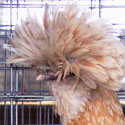
The Polish chicken breed was not developed in Poland, but in the Netherlands. It was originally intended as a layer of white-shell eggs, but the breed is now considered to be primarily ornamental because of its characteristic puffy head feathers, known as a crest or topknot.
The reason these chickens are called Polish has been lost to time. Here are some of the many theories:
- The chickens that were used to develop the Polish breed came from a region of Eastern Europe that was once part of Poland.
- Those original chickens were transported to Holland through a village with a name that has been interpreted as “Polish.”
- The breed’s topknot resembles feathered caps formerly worn by Polish soldiers.
- The breed name derives from the Middle Dutch word pol, meaning head or top.
Polish chickens are fun to keep as pets, are an excellent choice for showing at fairs and poultry shows, and make an attractive addition to any backyard flock. But keeping them is not without challenges. These same challenges apply to other crested breeds including Houdan and Sultan.
Picking
The first of these challenges occurs when Polish chicks start growing feathers on their knobby little heads. The pin feathers attract picking, which can lead to a bloody mess and even death. Chicks therefore need to be watched carefully during the brooding stage and rescued the moment picking starts. Clean and dry the wounded area, dim the brooder lights, and check to make sure the brooding temperature isn’t too high. If the wound is serious, separate the victim while the wound heals. If the Polish chicks are brooded with other breeds, sometimes moving the Polish chicks to a separate brooder will solve the problem. Picking can recur during each fall molt, so watch your Polish chickens for pin-feather picking during that time of year, as well.
Behavior Issues
Once the topknot has fully developed, the chickens may have trouble seeing well, especially if the head feathers hang over their eyes. Heavily bearded varieties are at a double disadvantage, because their vision is blocked from below as well as from above. As a result of vision issues, Polish chickens tend to be skittish, shying away from things (including their keeper) that seem to appear suddenly within their line of sight. If you are intent on hatching eggs from your Polish chickens, you may find that the roosters can’t see well enough to catch hens for mating.
Predation
An abundance of head feathers can interfere with a bird’s ability to see a predator coming. Polish and other crested chickens are therefore less suitable than non-crested breeds for free ranging. Even when crested birds have been alerted by other chickens that a predator is near, they may have a hard time finding their way to safety.
Freezing
Crested varieties are vulnerable to freezing if their copious head, and beard, feathers get wet. As a result, the wet feathers can become heavy with ice crystals, leading to frostbite. Head feathers may become wet if it rains just before the temperature drops. Topknot and beard feathers can also get soaked when a crested chicken takes a drink from a standard waterer.
The Fix
If your topknot chickens are not destined for the show circuit, trimming feathers away from their eyes would be kind, and could be life-saving. Use blunt tip scissors to cut back the feathers, as if you were giving the bird a haircut. Trim off the tips of the feathers only as far as needed so the bird can see. Not all Polish chickens need their crests trimmed; some have sparse head feathers, or their feathers part to the sides instead of falling over their eyes. Polish chickens being conditioned for exhibition require protective facilities and more careful management to keep them safe, healthy, and in top show condition.
Join the Club
If you are up for the challenge of keeping this unique breed, consider joining The Polish Breeders Club. This organization offers a wealth of information on caring for crested breeds, including not only Polish, but also Houdan, Sultan, and Crevecoeur chickens.
And that’s today’s news from the Cackle Coop.
Gail Damerow, author, Storey’s Guide to Raising Chickens

